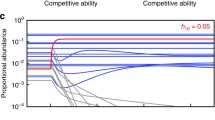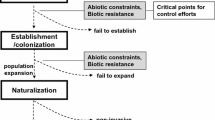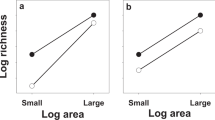Abstract
Invasion ecology has been criticised for its lack of general principles. To explore this criticism, we conducted a meta-analysis that examined characteristics of invasiveness (i.e. the ability of species to establish in, spread to, or become abundant in novel communities) and invasibility (i.e. the susceptibility of habitats to the establishment or proliferation of invaders). There were few consistencies among invasiveness characteristics (3 of 13): established and abundant invaders generally occupy similar habitats as native species, while abundant species tend to be less affected by enemies; germination success and reproductive output were significantly positively associated with invasiveness when results from both stages (establishment/spread and abundance/impact) were combined. Two of six invasibility characteristics were also significant: communities experiencing more disturbance and with higher resource availability sustained greater establishment and proliferation of invaders. We also found that even though ‘propagule pressure’ was considered in only ~29% of studies, it was a significant predictor of both invasiveness and invasibility (55 of 64 total cases). Given that nonindigenous species are likely introduced non-randomly, we contend that ‘propagule biases’ may confound current paradigms in invasion ecology. Examples of patterns that could be confounded by propagule biases include characteristics of good invaders and susceptible habitats, release from enemies, evolution of ‘invasiveness’, and invasional meltdown. We conclude that propagule pressure should serve as the basis of a null model for studies of biological invasions when inferring process from patterns of invasion.
Similar content being viewed by others
References
HG Baker, Characteristics and modes of origin of weeds. In: HG Baker and GL Stebbins (eds.) The Genetics of Colonizing Species. New York, USA: Academic Press (1965) pp. 147-169
HG Baker, The evolution of weeds. Annual Review of Ecology and Systematics 5 (1974) 1-24
LAJ Buchan and DK Padilla, Predicting the likelihood of Eurasian watermilfoil presence in lakes, a macrophyte monitoring tool. Ecological Applications 10 (2000) 1442-1455
MJW Burke and JP Grime, An experimental study of plant community invasibility. Ecology 77 (1996) 776-790
JT Carlton, Transoceanic and interoceanic dispersal of coastal marine organisms: the biology of ballast water. Oceanography and Marine Biology Annual Review 23 (1985) 313-371
JT Carlton, Pattern, process and prediction in marine invasion ecology. Biological Conservation 78 (1996) 97-106
P Cassey, Are there body size implications for the success of globally introduced land birds. Ecography 24 (2001) 413-420
P Cassey, TM Blackburn, KE Jones and JL Lockwood, Mistakes in the analysis of exotic species establishment: source pool designation and correlates of introduction success among parrots (Aves: Psittaciformes) of the world. Journal of Biogeography 31 (2004) 277-284
JF Clements, Birds of the World: a Checklist. Vista: Ibis (2000).
Colautti RI (2005) Are characteristics of introduced salmonid fishes biased by propagule pressure? Canadian Journal of Fisheries and Aquatic Sciences: 62: In Press.
RI Colautti and HJ MacIsaac, A neutral terminology to define invasive species. Diversity and Distributions 10 (2004) 135-141
Colautti RI, Muirhead JR, Biswas RN and MacIsaac HJ (2005) ‘Realized’ vs. ‘apparent’ reduction in enemies of the European starling (Sturnus vulgaris). Biological Invasions In Press.
RI Colautti, AJ Niimi, CDA Overdijk van, EL Mills, K Holeck and HJ MacIsaac, Spatial and temporal analysis of transoceanic shipping vectors to the Great Lakes. In: JT Carlton, GM Ruiz and RN Mack (eds.) Invasive Species: Vectors and Management Strategies. Washington, USA: Island Press (2004a) pp. 227-246
RI Colautti, A Ricciardi, IA Grigorovich and HJ MacIsaac, Does the enemy release hypothesis predict invasion success?. Ecology Letters 7 (2004b) 721-733
CR Darwin, On the Origin of Species by Means of Natural Selection, or the Preservation of Favoured Races in the Struggle for Life. London, UK: John Murray (1859).
MA Davis and M Pelsor, Experimental support for a resource-based mechanistic model of invasibility. Ecology Letters 4 (2001) 421-428
RP Duncan, The role of competition and introduction effort in the success of passeriform birds introduced to New Zealand. American Naturalist 149 (1997) 903-915
RP Duncan and TM Blackburn, Morphological over-dispersion in game birds (Aves : Galliformes) successfully introduced to New Zealand was not caused by interspecific competition. Evolutionary Ecology Research 4 (2002) 551-561
RP Duncan, TM Blackburn and D Sol, The ecology of bird introductions. Annual Review of Ecology, Evolution, and Systematics 34 (2003) 71-98
RP Duncan, M Bomford, DM Forsyth and L Conibear, High predictability in introduction outcomes and the geographical range size of introduced Australian birds: a role for climate. Journal of Animal Ecology 70 (2001) 621-632
PR Ehrlich, Attributes of invaders and the invading process: vertebrates. In: JA Drake, HA Mooney, F di Castri, RH Groves, FJ Kruger, M Rejmánek and M Williamson (eds.) Biological Invasions: a Global Perspective. New York, USA: John Wiley and Sons (1989) pp. 315-328
CS Elton, The Ecology of Invasions by Animals and Plants. London, UK: Methuen and Company (1958).
DM Forsyth and RP Duncan, Propagule size and the relative success of exotic ungulate and bird introductions to New Zealand. American Naturalist 157 (2001) 583-595
AJ Gray, Do invading species have definable genetic characteristics?. Philosophical Transactions of the Royal Society of London Series B 314 (1986) 655-674
FS Grevstad, Experimental invasions using biological control introductions: the influence of release size on the chance of population establishment. Biological Invasions 1 (1999) 313-323
IA Grigorovich, RI Colautti, EL Mills, KH Holeck, A Ballert and HJ MacIsaac, Ballast-mediated animal introductions in the Great Lakes: retrospective and prospective analysis. Canadian Journal of Fisheries and Aquatic Sciences 60 (2003) 740-756
JP Grover, Assembly rules for communities of nutrient limited plants and specialist herbivores. American Naturalist 143 (1994) 258-282
A Hector, B Schmid, C Beierkuhnlein, MC Caldeira, M Diemer, PG Dimitrakopoulos, JA Finn, H Freitas, HS Giller, J Good, R Harris, P Högberg, K Huss-Danell, J Joshi, A Jumpponen, C Körner, PW Leadley, M Loreau, A Minns, CPH Mulder, G O’Donovan, SJ Otway, JS Pereira, A Prinz, DJ Read, M Scherer-Lorenzen, ED Schulze, ASD Siamantziouras, EM Spehn, AC Terry, AY Troumbis, FI Woodward, S Yachi and JH Lawton, Plant diversity and productivity experiments in European grasslands. Science 286 (1999) 1123-1127
KR Hopper and RT Roush, Mate finding, dispersal, number released, and the success of biological control introductions. Ecological Entomology 18 (1993) 321-331
MA Huston, LW Aarssen, MP Austin, BS Cade, JD Fridley, E Garnier, JP Grime, J Hodgson, WK Lauenroth, K Thompson, JH Vandermeer and DA Wardle, No consistent effect of plant diversity on productivity. Science 289 (2000) 1255
RM Keane and MJ Crawley, Exotic plant invasions and the enemy release hypothesis. Trends in Ecology and Evolution 17 (2002) 164-170
CS Kolar and DM Lodge, Progress in invasion biology: predicting invaders. Trends in Ecology and Evolution 16 (2001) 199-204
CS Kolar and DM Lodge, Ecological predictions and risk assessment for alien fishes in North America. Science 298 (2002) 1233-1236
CE Lee, Evolutionary genetics of invasive species. Trends in Ecology and Evolution 17 (2002) 386-391
EA Leger and KJ Rice, Invasive California poppies (Eschscholzia californica Cham.) grow larger than native individuals under reduced competition. Ecology letters 6 (2003) 257-264
JM Levine, Species diversity and biological invasions: relating local process to community pattern. Science 288 (2000) 852-854
JM Levine, Local interactions, dispersal, and native and exotic plant diversity along a California stream. Oikos 95 (2001) 397-408
JM Levine and CM D’Antonio, Elton revisited: a review of evidence linking diversity and invasibility. Oikos 87 (1999) 15-26
JM Levine and CM D’Antonio, Forecasting biological invasion with increasing international trade. Conservation Biology 17 (2003) 322-326
JL Lockwood, Using taxonomy to predict success among introduced avifauna: relative importance of transport and establishment. Conservation Biology 13 (1999) 560-567
JL Lockwood and ML McKinney, Biotic Homogenization. New York, USA: Kluwer (2001).
DM Lodge, Biological invasions: lessons for ecology. Trends in Ecology and Evolution 8 (1993) 133-137
WM Lonsdale, Global patterns of plant invasions and the concept of invasibility. Ecology 80 (1999) 1522-1536
WM Lonsdale and AM Lane, Tourist vehicles as vectors of weed seeds in Kakadu National Park, Northern Australia. Biological Conservation 69 (1994) 277-283
K Lui, FL Thompson and CG Eckert, Causes and consequences of extreme variation in reproductive strategy and vegetative growth among invasive populations of a clonal aquatic plant, Butomus umbellatus L. (Butomaceae). Biological Invasions 6 (2004) 1-18
HJ MacIsaac, IA Grigorovich and A Ricciardi, Reassessment of species invasion concepts: the Great Lakes basin as a model. Biological Invasions 3 (2001) 405-416
RN Mack, Predicting the identity and fate of plant invaders: emergent and emerging approaches. Biological Conservation 78 (1996) 107-121
RN Mack and M Erneberg, The United States naturalized flora: largely the product of deliberate introductions. Annals of the Missouri Botanical Garden 89 (2002) 176-189
J McGrady-Steed, PM Harris and PJ Morin, Biodiversity regulates ecosystem predictability. Nature 390 (1997) 162-165
J Memmot, SJ Fowler and RL Hill, The effect of release size on the probability of establishment of biological control agents: gorse thrips (Sericothrips staphylinus) released against gorse (Ulex europaeus) in New Zealand. Biocontrol Science and Technology 8 (1998) 103-115
TE Miller, JM Kneitel and JH Burns, Effects of community structure on invasion success and rate. Ecology 83 (2002) 898-905
EL Mills, JH Leach, JT Carlton and CL Secor, Exotic species in the Great Lakes: a history of biotic crises and anthropogenic introductions. Journal of Great Lakes Research 19 (1993) 1-54
CE Mitchell and AG Power, Release of invasive plants from fungal and viral pathogens. Nature 421 (2003) 625-627
PB Moyle and T Light, Biological invasions of fresh water: empirical rules and assembly theory. Biological Conservation 78 (1996) 149-161
SH Reichard and CW Hamilton, Predicting invasions of woody plants introduced into North America. Conservation Biology 11 (1997) 193-203
M Rejmánek, Invasive plants: approaches and predictions. Austral Ecology 25 (2000) 497-506
A Ricciardi, Facilitative interactions among aquatic invaders: evidence of ‘invasional meltdown’ in the Great Lakes. Canadian Journal of Fisheries and Aquatic Sciences 58 (2001) 2513-2525
A Ricciardi and HJ MacIsaac, Recent mass invasion of the North American Great Lakes by Ponto-Caspian species. Trends in Ecology and Evolution 15 (2000) 62-65
DM Richardson, Forestry trees as invasive aliens. Conservation Biology 12 (1998) 18-26
DM Richardson, P Pyšek, M Rejmánek, MG Barbour, FD Panetta and CJ West, Naturalization and invasion of alien plants: concepts and definitions. Diversity and Distributions 6 (2000) 93-107
M Rouget and DM Richardson, Inferring process from pattern in plant invasions: a semi mechanistic model incorporating propagule pressure and environmental variables. American Naturalist 162 (2003) 713-724
GM Ruiz, PW Fofonoff, JT Carlton, MJ Wonham and AH Hines, Invasion of coastal marine communities in North America: apparent patterns, processes, and biases. Annual Review in Ecology and Systematics 31 (2000) 481-531
K Shea and P Chesson, Community ecology theory as a framework for biological invasions. Trends in Ecology and Evolution 14 (2002) 170-176
JB Shurin, Dispersal limitation, invasion resistance, and the structure of pond zooplankton communities. Ecology 81 (2000) 3074-3086
D Simberloff, Introduced insects: a biogeographic and systematic perspective. In: HA Mooney and JA Drake (eds.) Ecology of Biological Invasions of North America and Hawaii. New York, USA: Springer–Verlag (1986) pp. 3-26
D Simberloff, Which insect introductions succeed and which fail?. In: JA Drake, HA Mooney, F Castri di, RH Groves, FJ Kruger, M Rejmanek and M Williamson (eds.) Biological Invasions: a Global Perspective. New York, USA: Wiley (1989) pp. 61-75
D Simberloff and B Holle Von, Positive interactions of nonindigenous species: invasional meltdown. Biological Invasions 1 (1999) 21-32
D Simberloff, MA Relva and M Nunez, Introduced species and management of a Nothofagus/Austrocedrus forest. Environmental Management 31 (2003) 263-275
RR Sokal and FJ Rohlf, Biometry. New York: W.H. Freeman (1995).
D Sol and L Lefebvre, Behavioural flexibility predicts invasion success in birds introduced to New Zealand. Oikos 90 (2000) 599-605
JJ Stachowicz, RB Whitlatch and RW Osman, Species diversity and invasion resistance in a marine ecosystem. Science 286 (1999) 1577-1579
ME Torchin, KD Lafferty and AM Kuris, Release from parasites as natural enemies: increased performance of a globally introduced marine crab. Biological Invasions 3 (2003) 333-345
KC Tucker and DM Richardson, An expert system for␣screening potentially invasive alien plants in South African fynbos. Journal of Environmental Management 44 (1995) 309-338
J Ruijven Van, GB Deyn De and F Berendse, Diversity reduces invisibility in experimental plant communities: the role of plant species. Ecology Letters 6 (2003) 910-918
CJ Veltman, S Nee and MJ Crawley, Correlates of introduction success in exotic New Zealand birds. The American Naturalist 147 (1996) 542-557
M Vilà and J Pujadas, Land-use and socio-economic correlates of plant invasions in European and North African countries. Biological Conservation 100 (2001) 397-401
M Williamson, Biological Invasions. London UK: Chapman Hall (1996).
MJ Wonham, JT Carlton, GM Ruiz and LD Smith, Fish and ships: relating dispersal frequency to success in biological invasions. Marine Biology 136 (2000) 1111-1121
Author information
Authors and Affiliations
Corresponding author
Additional information
An erratum to this article can be found at http://dx.doi.org/10.1007/s10530-006-9007-7
Rights and permissions
About this article
Cite this article
Colautti, R.I., Grigorovich, I.A. & MacIsaac, H.J. Propagule Pressure: A Null Model for Biological Invasions. Biol Invasions 8, 1023–1037 (2006). https://doi.org/10.1007/s10530-005-3735-y
Received:
Accepted:
Published:
Issue Date:
DOI: https://doi.org/10.1007/s10530-005-3735-y




